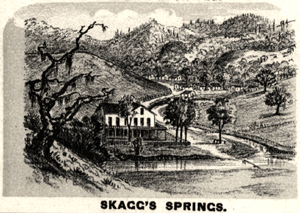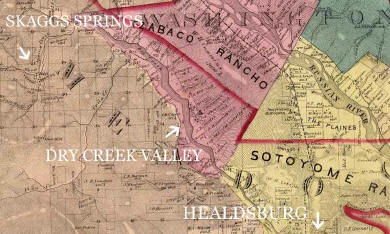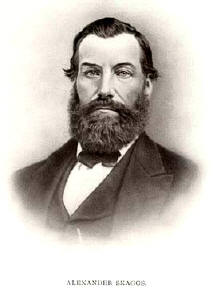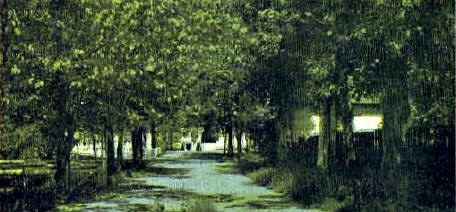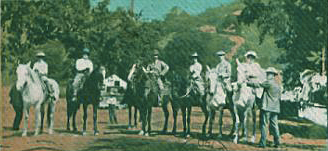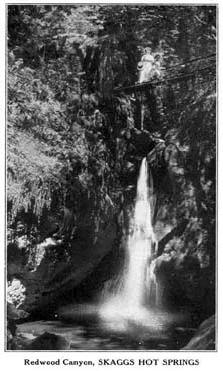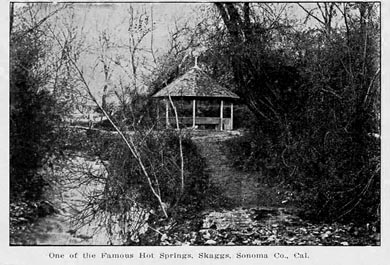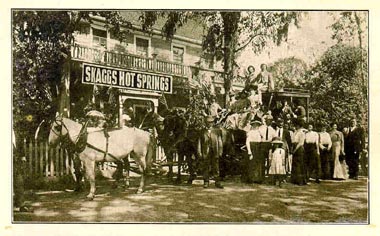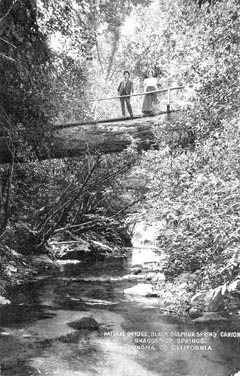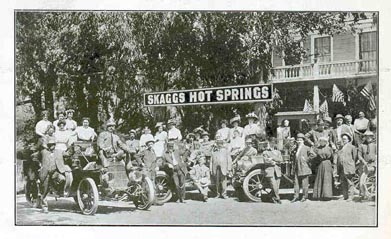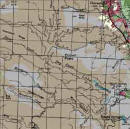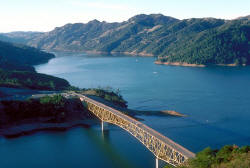|
|
urHealdsburg.com |
||||||||||||||||||
|
|
|||||||||||||||||||
|
Squatter Captain, Alexander Skaggs and his Hot Springs Resort
By virtue of a fortunate geologic quirk, some parts of Sonoma County are punctured by bubbling hot mineral springs. Not long after the first American settlers arrived those springs had spawned a thriving health resort industry that drew tourists and invalids from all over the state. One of the earliest and largest of the hot springs resorts was Skaggs Hot Springs, a small level valley tucked into a hilly region about nine miles west of Geyserville. Alexander Skaggs began building his resort there in the late 1850’s.
Elizabeth Pohley remembered the old resort. As a child Elizabeth lived with her "Aunt Missouri" (Mrs. Elijah Skaggs). She remembered the excitement when she was lifted aboard the front seat of the "auto stage" bound for the Springs. Masterfully guiding that particular stage was one of the Lampson brothers out of Geyserville.[1] The Pohleys and many Bay Area families spent happy vacations at Skaggs Hot Springs during the 1920's. Then came the crash of 1929, which wiped out most of their disposable income, meaning the end of resort vacations. The Second World War and gas rationing gave the knockout blow, and the Hotel closed in 1942. Now the old resort site, along with its relics, lie submerged under Lake Sonoma. Although some, like Mrs. Pohley, remember the Resort, no one living can recall its peak in the late 1870's, when it often drew as many as 300 people a day.
Captain of the Squatters The enterprise started with a rather fascinating fellow, Alexander Skaggs, who first came to Sonoma County in 1857. This was not his first stop. He and his wife, Eliza Thomas, both natives of Kentucky, came overland to California from Missouri in 1853, driving a herd of cattle before them. For the next four years they raised stock in Nevada County before arriving in this vicinity. Here Skaggs and his family, along with some of his former black slaves, settled to farm on the Sotoyome Rancho. They, like so many other families who settled here in that era, were squatters, illegal settlers on land owned by others.[2] I first "met" Alexander Skaggs while doing research on those feisty squatter families and the ensuing battles with authorities that became the longest-running squatter uprising in the State. Skaggs and company were in the thick of those battles, and "Captain Skaggs", head of the pseudo-military squatter rebels, acted as their spokesman at a standoff with the County Sheriff and his posse near Healdsburg in 1862.[3] The Skaggs family was eventually driven off their coveted lower Dry Creek farmlands, like all of those who settled illegally. But even amidst the battles with enforcement officials, Alexander Skaggs and his brother, William, laid claim in 1857 to 160 acres of land in the public domain, a site where three different hot springs bubbled from crevices in the rock formations. The Skaggs brothers later added considerably to that first patent, forming a cattle-grazing operation on just over 1300 acres.[4]
300 Guests a Day By 1860 the Skaggs family had established a resort that may have seen as many as 20 guests a day. With visitors on the increase they built a redwood hotel in 1864, and an addition the next year. By 1877, with the help of the new railroad to Healdsburg, that hotel played host to 300 invalids, tourists, and vacationers on a good day. Most of them were from San Francisco, or cities in Marin and Sonoma Counties. They christened the rooms and cottages with names like Oakland, Magnolia (also known as Murderer's Row), Knob Hill, San Rafael, San Francisco, and Santa Rosa. Giving evidence of their points of origin, these names were meant to make the guests feel at home.[5]
If we arrived at Skaggs Hot Springs in the mid-1870's we might have visited the barroom for much needed libations before inspecting one of the 24 sleeping rooms. There we might have cleaned up before dining in the public, or if we were wealthy, in the private dining room. Outside we might admire the east garden, or pay a visit to the barn, horse corral, and hog pen. Later we might stroll with other guests past the five or six cottages set along Little Warm Springs Creek, or the employee houses and "shanties" that now populated the growing complex. If we had arrived late on a crowded evening, however, we might have had to make do with accommodations in one of the seasonal tent structures that housed the overflow. 130-Degree Alkaline Bath or Cold Soda and Iron Spring Sources differ as to whether there were three or four hot springs, but they agree that spring water ran along a 900-foot pipe into the Hotel kitchen. something so comforting as a 130-degree alkaline bath was not enough. According to an 1877 atlas, the main attraction for the health conscious was, "...a cold soda and iron spring, a valuable tonic for invalids." What ailed the invalids was not recorded, but mineral springs were popular with those suffering from tuberculosis.
Over each spring was a gazebo with benches along the inside, and a small pool in the center. Metal dippers hung from hooks for drinking and, it seems probable, also spread infectious diseases.[6] A railway advertisement for the Resort circa 1915 lists room and board for $12 to $14 per person. Children under 12 were counted as half price. That same listing announced a detailed inventory of the mineral content of the springs, including Sodium Bi-Carbonate, Sodium Bi-Borate, and Magnesium Carbonate.[7] Before the railroad, vacationers traveled the entire distance to the Springs by horseback or horse drawn stage. Later the train brought them to Geyserville and then by stage overland. Some stayed overnight in Geyserville at the Skaggs Hotel, run by Julia Skaggs, daughter-in-law of Alexander Skaggs. After 1912 passengers in Geyserville were loaded aboard a Moorland truck, a Studebaker seven-passenger touring car, or a Ford truck to make the journey to the Hot Springs. In addition to the Lampson brothers, Healdsburg fire chief, Harold Sullivan, also drove this route at one-time.[8] Fist Fights and Land Rights Founder Alexander Skaggs managed the resort until about 1867. Thereafter he tried renting the resort to a series of managers that included B.F. Tucker (for whom Tucker Street in Healdsburg is named) and, beginning in 1872, a man named Perry Emerson. Trouble followed soon after. According to court records, Skaggs and Emerson got into a fist fight over the resort on or about March 1, 1873, which would be just about the start of the tourist season. Skaggs claimed that Emerson was not paying his rent or running things properly. Skaggs won the first court battle by getting an order to have Emerson evicted. On October 28, however, just three days before Skaggs was to repossess the resort, the Hotel building burned. Skaggs formed an entirely understandable conviction that Emerson and his cohorts deliberately started the fire. But that conviction was not upheld in court and charges against the errant manager were dismissed. The basis of Skaggs' disputes with Emerson and several other neighbors appears to have been disputed ownership of the Hot Springs land. Just as Alexander had done himself in the Dry Creek Valley a decade earlier, several parties, including L. Caldwell, L. Litton, and Harvey Truett, "commenced jumping in and building shanties" on the resort land. Now Mr. Skaggs was the landlord trying to protect his claim against squatters. Sheriffs Retire to Springs The only record found regarding the hotel rebuilding after the fire is a mortgage record, which indicates that it was rebuilt almost immediately. This time it had 17 (instead of 24) guest rooms, a parlor, a barbershop and an office.[9]
Perhaps soured on hired management, Skaggs himself or members of his family ran the hotel until the mid 1880's, when the patriarch bought a ranch in Santa Rosa. Later he moved to San Francisco, where he died in 1897. His son, George H. Skaggs, took over the operation of the resort for a few years after his father’s departure. A series of operators then ensued, including J.P. Mulgrew, a former Sonoma County Sheriff and Tax Collector, from the early 1890's to 1907.[10] It was in 1909 that another former Sheriff and Supervisor, this time from San Francisco, assumed management and later purchased the resort. Peter J. Curtis and his son, Peter Leo Curtis played host until the hotel closed in 1942. Frigidaires, Velvet Baths, and Hungry Hot-tubbers Under the Curtis family Skaggs Hot Springs Hotel finally got a "Frigidaire Conversion", a distinct improvement over the "cool room" that needed a 300 pound block of ice delivered from Healdsburg each day. Now there was also a swimming pool, an enlarged bathhouse, showers, and "hot plunges", which were large tubs for soaking. The waters in those plunges were said to be so soft and relaxing that patrons called them "velvet baths". The “massage department” provided extra relaxation. For the sports minded there were handball and croquet courts, a bocci ball alley, and billiard and pool tables. Of course the rugged mountain trails were a natural for horseback riding. In the evening guests socialized with renewed vigor in the dance hall, built with one open wall facing a wide hotel verandah. High on a hilltop about two miles away lived a French family, the Bourdens. "Miss Annie” Bourden served delicious chicken dinners on redwood tables under a monumental grape arbor. “The view of the surrounding country was breathtaking,” remembered Charlotte M. Curtis in 1976. Between the resort and the Bourdens home stretched a single wire telephone line. At noon a phone call to “Miss Annie” told her how many to expect for dinner, and later that afternoon a wagon load of hungry hot tubbers ascended the hill.[11] When tourists began arriving in their own cars, the number of visitors picked up at the resort, but the length of stay shortened considerably. In the old days families commonly stayed a month or two while Father visited from the Bay Area on weekends. Weekenders or day-trippers were more common from about 1920 to the hotel's closing in 1942. Mysterious Fate A brief and unsuccessful attempt was made to revive the Springs after World War II. Martin L. Morgan and his wife bought the land, refurbished the grounds, the old pool, and opened a cafe.[12] There is a small mystery about the fate of the old Hotel thereafter, at least as to when it burned or was dismantled. Some say that "hippies" were living in the abandoned hotel building when it burned in the late 1940's. Local historian William Shipley concurred that the hotel burned down prior to 1950. Others say that Bill Petray simply dismantled it before 1947. Lumber from dismantled buildings on the site was hauled to Windsor between 1942 and 1948.[13] Now all traces of Skaggs Hot Springs and Hotel lie at the bottom of a lake, viewed only by fishes. © 2003 Hannah Clayborn
|
|||||||||||||||||||
|
|
|||||||||||||||||||
